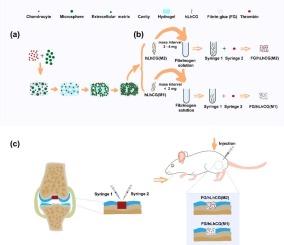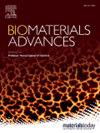用于关节软骨缺损再生的可注射组织工程人软骨基质复合纤维蛋白胶水
IF 5.5
2区 医学
Q2 MATERIALS SCIENCE, BIOMATERIALS
Materials Science & Engineering C-Materials for Biological Applications
Pub Date : 2024-10-31
DOI:10.1016/j.bioadv.2024.214095
引用次数: 0
摘要
由于缺乏血管和神经,软骨的自我修复能力有限,关节软骨损伤急需有效治疗。目前,临床修复软骨缺损的局限性在于难以形成纯净的透明软骨修复体,软骨组织和细胞来源有限。为了获得高纯度的再生透明软骨,我们提出以人软骨细胞分泌的活体透明软骨移植物(hLhCG)为分散相,以纤维蛋白原溶液为连续相,构建可注射的水凝胶前体,通过凝血酶双重注射,在凝血酶作用下形成三维网络水凝胶结构,修复关节缺损。实验验证了 hLhCG 的组分表型和复合凝胶支架的生物力学特性。在缺损部位注射混合相 12 周后,再生组织的成分与邻近的天然组织相似,并表现出相似的生物力学特性。再生软骨的表型得到了验证,证实了透明软骨的成功再生。本文章由计算机程序翻译,如有差异,请以英文原文为准。

Injectable tissue-engineered human cartilage matrix composite fibrin glue for regeneration of articular cartilage defects
Due to the lack of blood vessels and nerves, the ability of cartilage to repair itself is limited, and the injury of articular cartilage urgently needs effective treatment. Currently, the limitation of clinical repair for cartilage defects is that it is difficult to form pure hyaline cartilage repair, and the source of cartilage tissue and cells is limited. To obtain high-purity regenerated hyaline cartilage, we proposed to construct an injectable hydrogel precursor by using human living hyaline cartilage graft (hLhCG) secreted by human chondrocytes as the dispersed phase and fibrinogen solution as the continuous phase, by double injection with thrombin, three-dimensional network hydrogel structure was formed under the action of thrombin to repair joint defects. The component phenotypes of hLhCG and biomechanical properties of composite gel scaffolds were verified. After 12 weeks of injection of the mixed phase at the defect site, the regenerated tissues are similar in composition to adjacent natural tissues and exhibit similar biomechanical properties. The phenotype of regenerated cartilage was verified, confirming the successful regeneration of hyaline cartilage.
求助全文
通过发布文献求助,成功后即可免费获取论文全文。
去求助
来源期刊
CiteScore
17.80
自引率
0.00%
发文量
501
审稿时长
27 days
期刊介绍:
Biomaterials Advances, previously known as Materials Science and Engineering: C-Materials for Biological Applications (P-ISSN: 0928-4931, E-ISSN: 1873-0191). Includes topics at the interface of the biomedical sciences and materials engineering. These topics include:
• Bioinspired and biomimetic materials for medical applications
• Materials of biological origin for medical applications
• Materials for "active" medical applications
• Self-assembling and self-healing materials for medical applications
• "Smart" (i.e., stimulus-response) materials for medical applications
• Ceramic, metallic, polymeric, and composite materials for medical applications
• Materials for in vivo sensing
• Materials for in vivo imaging
• Materials for delivery of pharmacologic agents and vaccines
• Novel approaches for characterizing and modeling materials for medical applications
Manuscripts on biological topics without a materials science component, or manuscripts on materials science without biological applications, will not be considered for publication in Materials Science and Engineering C. New submissions are first assessed for language, scope and originality (plagiarism check) and can be desk rejected before review if they need English language improvements, are out of scope or present excessive duplication with published sources.
Biomaterials Advances sits within Elsevier''s biomaterials science portfolio alongside Biomaterials, Materials Today Bio and Biomaterials and Biosystems. As part of the broader Materials Today family, Biomaterials Advances offers authors rigorous peer review, rapid decisions, and high visibility. We look forward to receiving your submissions!

 求助内容:
求助内容: 应助结果提醒方式:
应助结果提醒方式:


